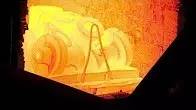Quenching and tempering treatment: The heat treatment method of high temperature tempering after quenching is called quenching and tempering treatment. High temperature tempering refers to tempering between 500-650 °C. Quenching and tempering can make the properties and materials of steel get a large degree of adjustment, and its strength, plasticity and toughness are good, and it has good comprehensive mechanical properties.

After quenching and tempering treatment, tempered sorbite is obtained. Tempered sorbite is formed when martensite is tempered and can be distinguished by magnifying 500~600 times under optical metallographic microscope. It is a carbide in the ferrite matrix (including osmosis). Carbon body) composite structure of pellets. It is also a tempering structure of martensite, a mixture of ferrite and granular carbide. At this time, the ferrite has substantially no carbon supersaturation, and the carbide is also a stable carbide. At room temperature is a balanced organization.
Quenched and tempered steel has two major categories: carbon quenched and tempered steel and alloy quenched and tempered steel. Whether it is carbon steel or alloy steel, its carbon content is strictly controlled. If the carbon content is too high, the strength of the workpiece after quenching and tempering is high, but the toughness is not enough. If the carbon content is too low, the toughness is increased and the strength is insufficient. In order to obtain good overall performance of the tempering part, the carbon content is generally controlled at 0.30~0.50%.
During quenching and quenching, the entire section of the workpiece is required to be hardened, so that the workpiece is obtained by fine-stacked quenched martensite. By tempering at a high temperature, a microstructure mainly composed of uniform tempered sorbite is obtained. It is impossible for a small factory to conduct metallographic analysis for each furnace. Generally, it is only used for hardness testing. That is to say, the hardness after quenching must reach the quenching hardness of the material, and the hardness after tempering is checked according to the requirements of the drawing.

45 steel is a medium carbon structural steel with good hot and cold processing properties, good mechanical properties, low price and wide source, so it is widely used. Its biggest weakness is that the workpiece with low hardenability, large cross-section size and high requirements is not suitable.
45 steel quenching temperature is A3 + (30 ~ 50) ° C, in actual operation, generally take the upper limit. The high quenching temperature can accelerate the heating of the workpiece, reduce the surface oxidation, and improve the work efficiency. In order to homogenize the austenite of the workpiece, sufficient holding time is required. If the actual amount of furnace is large, it is necessary to extend the holding time appropriately. Otherwise, there may be a phenomenon of insufficient hardness due to uneven heating. However, if the holding time is too long, there will also be coarse grains, serious oxidative decarburization, and affect the quality of quenching. We believe that if the furnace volume is greater than the specification of the process documentation, the heating and holding time needs to be extended by 1/5.
Because 45 steel has low hardenability, a 10% brine solution with a high cooling rate should be used. After the workpiece enters the water, it should be hardened, but not cold. If the workpiece is cold in the brine, it may crack the workpiece. When the workpiece is cooled to about 180 °C, the austenite is rapidly transformed into martensite. Excessive tissue stress. Therefore, when the quenched workpiece is rapidly cooled to this temperature range, a slow cooling method should be adopted. Since the water temperature is difficult to grasp, it must be operated by experience. When the workpiece in the water is shaken, the water can be cooled (if it can be oil-cooled). In addition, the workpiece should not be static when it enters the water, and should be regularly moved according to the geometry of the workpiece. The static cooling medium plus the stationary workpiece results in uneven hardness and uneven stress, which causes the workpiece to deform greatly and even crack.
The hardness of 45 steel tempering parts after quenching should reach HRC56~59, the possibility of large cross section is lower, but it can't be lower than HRC48. Otherwise, it means that the workpiece is not completely quenched, and there may be Sorbite or even ferrite in the structure. Organizations, such organizations, through tempering, remain in the matrix and do not achieve the purpose of quenching and tempering.
After high temperature tempering of 45 steel after quenching, the heating temperature is usually 560~600 °C, and the hardness requirement is HRC22~34. Because the purpose of quenching and tempering is to obtain comprehensive mechanical properties, the hardness range is relatively wide. However, if the drawings have hardness requirements, the tempering temperature should be adjusted according to the drawings to ensure the hardness. For example, some shaft parts require high strength and high hardness requirements; while some gears and shaft parts with keyways are milled and inserted after quenching and tempering, and the hardness requirements are lower. Regarding the tempering holding time, depending on the hardness requirements and the size of the workpiece, we believe that the hardness after tempering depends on the tempering temperature, and has little to do with the tempering time, but it must be reciprocated, and the general workpiece tempering time is always More than an hour.